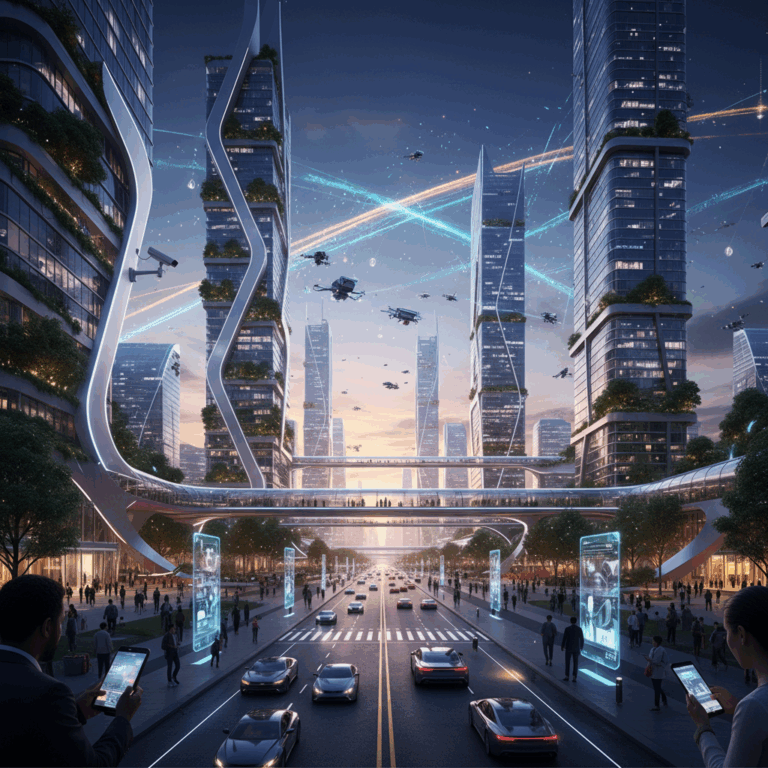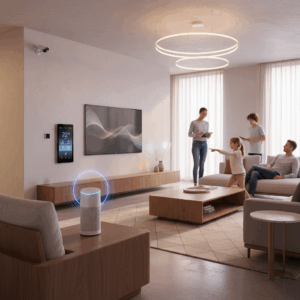Technology Foundations of Smart Cities
Smart cities are built on the integration of advanced technologies that transform urban environments. These foundations enable efficient resource management and improved services for residents.
The core technologies include the Internet of Things (IoT), artificial intelligence (AI), and high-speed connectivity like 5G. Together, they support real-time data exchange and smarter infrastructure.
Integration of IoT, AI, and Connectivity
The seamless integration of IoT devices, AI algorithms, and robust connectivity is essential for smart city operations. Sensors gather data, AI interprets it, and communication networks ensure swift data flow.
IoT sensors monitor everything from traffic flow to environmental conditions, while AI processes this information to optimize urban functions. Connectivity such as 5G guarantees low-latency communication needed for real-time decisions.
This triad of technologies enables dynamic traffic control, energy management, and public safety enhancements, creating more responsive and adaptive urban systems.
Data Infrastructure and Analytics
Smart cities rely on a robust data infrastructure capable of handling vast volumes of information collected by IoT devices. Data analytics platforms transform raw data into actionable insights.
Advanced analytics techniques, including machine learning, help predict trends and optimize municipal services. Strong data management supports better governance and enhances citizens’ quality of life.
High-speed networks, large-scale cloud storage, and edge computing work together to process and deliver data rapidly, supporting the complex demands of smart city environments.
Urban Mobility and Energy Efficiency Improvements
Urban mobility and energy efficiency are critical focuses for smart cities aiming to reduce congestion and environmental impact. Innovative technologies make transportation and energy use smarter and more sustainable.
By leveraging AI and IoT, cities can optimize traffic flows, improve energy distribution, and monitor environmental quality, resulting in enhanced urban living conditions and lower carbon footprints.
AI-Driven Traffic Management Systems
AI-driven traffic management uses real-time data from sensors and cameras to dynamically adjust signal timings, reducing traffic jams and emissions. This system adapts to actual flow rather than fixed schedules.
Cities such as Los Angeles have significantly lowered vehicle wait times and pollution by employing AI models that predict traffic patterns and optimize routes for better flow and fewer delays.
These intelligent systems also enable rapid responses to incidents or road changes, improving safety and reducing travel disruption through proactive management and data analysis.
Energy Optimization and Renewable Integration
Smart cities optimize energy consumption by integrating renewable sources like solar power into public infrastructure, reducing reliance on fossil fuels and promoting sustainability across urban environments.
Connected technologies allow streetlights and public facilities to adjust energy usage based on real-time conditions, such as dimming lights when no one is nearby to save power.
Energy management platforms use data analytics to forecast demand and efficiently distribute resources, enabling cost savings and reducing environmental impact citywide.
Environmental Monitoring with IoT Sensors
IoT sensors continuously monitor air quality, temperature, and noise levels in urban areas, providing critical data to safeguard public health and maintain environmental standards.
This real-time monitoring helps authorities identify pollution hotspots and take timely actions, improving air and water quality and enhancing residents’ wellbeing.
Such sensor networks support sustainable urban management, enabling data-driven decisions that minimize environmental risks and promote greener, healthier cities.
Enhancing Public Safety and Citizen Engagement
Smart city technology significantly boosts public safety by deploying intelligent surveillance and rapid emergency response systems. These innovations create safer urban spaces for all.
Moreover, digital platforms enable enhanced citizen engagement, allowing residents to actively participate in governance and community affairs, fostering transparency and collaboration.
Smart Surveillance and Emergency Responses
Smart surveillance systems utilize AI-powered cameras and sensors to monitor real-time activities, detecting unusual behaviors to prevent crimes and enhance safety.
Emergency response systems integrate data from multiple sources, enabling faster dispatch and coordination of services like police, fire, and medical teams.
Intelligent lighting and location-based alerts also improve security in public spaces, reducing risks and creating a safer environment for residents and visitors alike.
Digital Platforms for Community Participation
Digital platforms empower citizens by providing tools to report issues, share feedback, and access city information, fostering active participation in urban management.
These interactive portals enhance transparency and trust by enabling dialogue between residents and local authorities, improving decision-making and service delivery.
Engaging communities through technology strengthens social ties and encourages collaborative problem-solving, which is vital for resilient and inclusive smart cities.
Challenges and Future Outlook
As smart city technologies evolve, they bring significant benefits but also present critical challenges. Addressing these is essential for sustainable urban growth.
Key concerns include privacy, data security, and ensuring technologies support resilient, sustainable communities while protecting citizens.
Privacy and Data Security Concerns
Smart cities rely on massive data collection, raising concerns over personal privacy and data protection. Safeguarding this data is crucial to maintain citizen trust.
Security breaches or misuse of data can compromise safety and privacy. Strong encryption, transparent policies, and regulatory frameworks are necessary to mitigate risks.
Public awareness and involvement in data governance also play vital roles in balancing innovation with ethical data use in smart urban environments.
Goals for Sustainable and Resilient Urban Living
The future of smart cities centers on creating sustainable, resilient urban spaces that adapt to environmental and social challenges while enhancing quality of life.
Integrating renewable energy, improving resource efficiency, and fostering community engagement support long-term urban sustainability goals.
Innovations in technology must align with environmental stewardship and social inclusion to ensure smart cities thrive amid growing global urbanization pressures.






